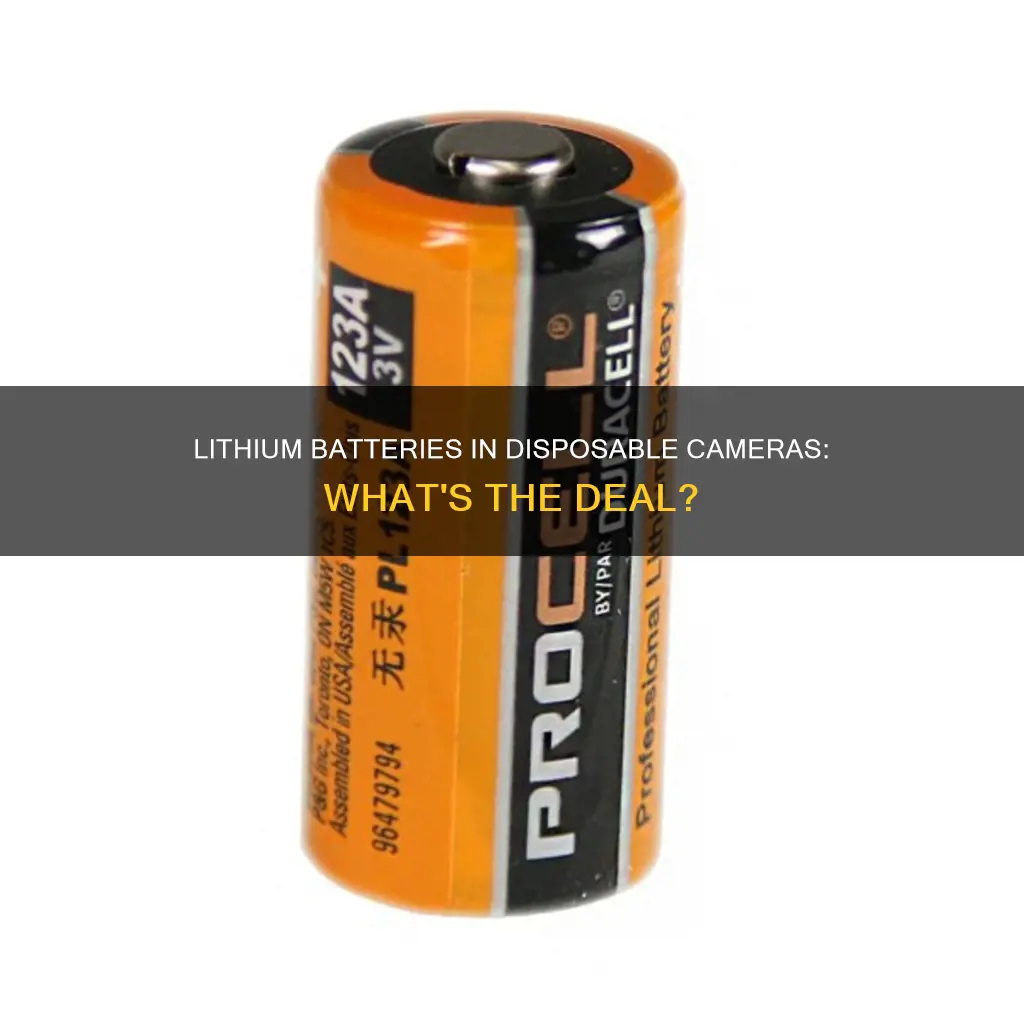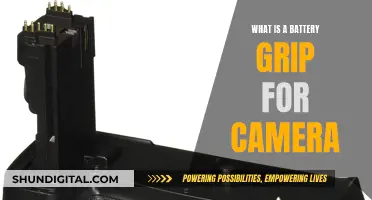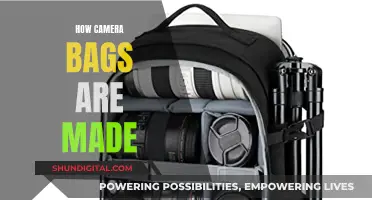
Disposable cameras, also known as single-use cameras, are compact, simple cameras that come loaded with either colour or black-and-white film. They are designed to be used once and then sent for processing. These cameras are typically made of plastic, paper, cardboard, and steel, and are powered by a battery that fuels the built-in flash. While the exact type of battery varies, some disposable cameras contain lithium batteries, while others use alkaline manganese batteries. This raises concerns about the environmental impact of disposable cameras, as the batteries contain heavy metals that can cause soil and water contamination if not properly disposed of or recycled.
| Characteristics | Values |
|---|---|
| Battery type | Alkaline manganese battery |
| Recyclability | The outer casing is made of plastic, which can be recycled but requires a lot of energy. The battery can be recycled separately but can cause soil and water contamination if not handled properly. |
What You'll Learn
- Disposable cameras typically use alkaline manganese batteries, not lithium-ion
- Batteries in disposable cameras can be recycled separately
- Improper disposal of disposable cameras can lead to environmental issues
- Batteries may leak harmful chemicals if the camera ends up in a landfill
- Some recycling facilities do not accept cameras with batteries still inside

Disposable cameras typically use alkaline manganese batteries, not lithium-ion
Disposable cameras, also known as single-use cameras, are simple, pre-loaded film cameras designed for one-time use. They are typically characterised by a simple plastic body and lens, fixed focus and exposure settings, and a built-in flash. Their main appeal lies in their simplicity, durability, and practicality, making them ideal for various situations such as beach trips, festivals, and travel.
While disposable cameras offer numerous benefits, one important consideration is their environmental impact. The outer casing, film, battery, and other internal components contribute to their environmental footprint. Proper disposal and recycling are essential to minimise potential harm.
Regarding the battery type, it is important to note that disposable cameras typically use alkaline manganese batteries, as indicated by a user attempting to ship a disposable camera overseas. This type of battery is not a lithium-ion or rechargeable battery. This distinction is crucial, especially in the context of transportation and shipping regulations, as different types of batteries may have specific requirements and restrictions.
Alkaline manganese batteries, often found in disposable cameras, have their own set of advantages and considerations. They offer a stable power source for the camera's functions, including the flash. However, when it comes to disposal, these batteries contain heavy metals that can be harmful to the environment if not properly handled and recycled.
In summary, disposable cameras provide a convenient and straightforward approach to photography. Their typical use of alkaline manganese batteries, as opposed to lithium-ion batteries, is an important detail to be aware of, especially when considering shipping or disposal. Proper recycling practices are essential to mitigate the environmental impact of these single-use cameras.
Wireless Security Cameras: How Long Do They Last?
You may want to see also

Batteries in disposable cameras can be recycled separately
Disposable cameras have a certain appeal. They are simple, convenient, and offer a unique, candid approach to photography. However, their environmental impact is a significant concern. While some components of disposable cameras can be recycled, the process is complex and energy-intensive, and not all areas have facilities to recycle them.
The batteries in disposable cameras are often a source of worry due to the heavy metals they contain. These batteries, if not disposed of properly, can cause soil and water contamination. However, they can be recycled separately, and this is an important step to take to reduce the environmental harm caused by these single-use devices.
Recycling batteries from disposable cameras is a responsible action that helps prevent the release of harmful substances into the environment. It is worth noting that different types of batteries are found in disposable cameras, and proper identification is crucial for safe disposal. For instance, alkaline manganese batteries are different from lithium-ion or rechargeable batteries and may require specific recycling procedures.
Recycling programs offered by camera manufacturers, such as Kodak, Fujifilm, Canon, and HP, provide an environmentally friendly way to dispose of disposable cameras. These programs ensure that the plastic, metal, and glass components are recycled, reducing waste and preserving natural resources.
To recycle batteries separately, individuals can contact local recycling centers or specialized companies that handle electronic waste disposal. Proper disposal of batteries is a critical step in the responsible recycling of disposable cameras, ensuring that the environment is protected from harmful substances.
Charging the Vantop Moment 4: A Step-by-Step Guide
You may want to see also

Improper disposal of disposable cameras can lead to environmental issues
Disposable cameras have been the subject of controversy since their inception in 1986. They were initially designed to be thrown away, and this sparked outrage in the community, with Kodak even receiving a "Waste Maker of the Year" award from a US Senator. Due to public pressure, manufacturers introduced recycling programs. However, it appears that these programs have become less prevalent in recent years, coinciding with the decline in disposable camera use. This has resulted in a surge of unrecyclable waste, with many of the 10 million or more disposable cameras sold annually worldwide ending up in landfills.
The improper disposal of disposable cameras can lead to significant environmental issues. These cameras contain batteries, often alkaline manganese batteries, which can be hazardous if not disposed of properly. In addition, the plastic and electronic components of disposable cameras can cause environmental damage if they are not recycled or reused.
Recycling disposable cameras can help mitigate these issues. The cameras can be disassembled, and their parts recycled or reused. The plastic housings, for example, can be re-pelletized and remolded into new housings, while other key components such as the flash, lenses, and viewfinders can be salvaged and reassembled into new cameras. This process is already in place for some manufacturers, such as Fujifilm, which claims that up to 60% of its QuickSnap one-time-use cameras are manufactured with reused camera materials.
However, it is important to note that not all recycling programs are equal. Some programs, like Fujifilm's, recycle both the plastic and electronic components of their cameras. In contrast, others may only recycle the plastic parts, ignoring the electronics, which can be just as harmful to the environment. Furthermore, some third-party disposable camera manufacturers do not appear to have any recycling programs in place at all.
To reduce the environmental impact of disposable cameras, consumers should be mindful of the recycling options available for the specific brand of camera they are using. They should also consider reducing their use of disposable cameras in favor of reusable alternatives, such as traditional film or digital cameras, to minimize waste and the environmental footprint associated with the recycling process.
Camera Batteries: Do They Have an Expiry Date?
You may want to see also

Batteries may leak harmful chemicals if the camera ends up in a landfill
Disposable cameras are not eco-friendly in terms of what they are made of. The majority of a disposable camera is made of plastic, with several electrical components, including a battery, to control the flash and shutter. These electrical components can pose a problem if a disposable camera ends up in a landfill.
The battery in a disposable camera is usually an alkaline manganese battery, not a lithium-ion or rechargeable one. However, if a disposable camera is thrown away and ends up in a landfill, the battery may leak harmful chemicals over time. This is because the landfill site is unlikely to be a suitable environment for the battery, and the disposal method may not be appropriate.
To avoid this, it is important to dispose of disposable cameras properly. The best way to do this is to take the camera to a film developer, who will usually have a recycling program in place for the camera and its components, including the battery. Some companies, such as Fujifilm, have been recycling their disposable cameras since 1990. They melt and remould the plastic parts, clean and reuse other parts, and recycle the batteries.
If you remove the film yourself to be developed, you should not throw away the rest of the camera. Instead, look for a recycling program that accepts disposable cameras, such as Fujifilm's QuickSnap One-Time Use Camera Recycling program. This way, you can help ensure that the camera's plastic parts are reused or recycled, and the battery is disposed of properly.
By taking these steps, you can help prevent the potential leakage of harmful chemicals from disposable camera batteries in landfills and reduce the environmental impact of these single-use products.
Zumimall Camera Charging Time: How Long Should You Wait?
You may want to see also

Some recycling facilities do not accept cameras with batteries still inside
Disposable cameras typically contain alkaline manganese batteries, which are neither lithium-ion nor rechargeable. However, the presence of batteries in cameras can pose challenges when it comes to recycling.
While batteries are essential for powering devices like disposable cameras, their proper disposal is crucial for environmental and safety reasons. Recycling facilities play a vital role in this process, but it's important to note that not all facilities accept cameras with batteries still inside. This is because certain batteries, such as lithium-ion batteries, can be a fire hazard if not handled correctly.
Recycling facilities have different capabilities and restrictions when it comes to processing batteries. Some facilities may not have the necessary equipment or expertise to handle certain types of batteries safely. Additionally, there are varying regulations and standards for battery disposal across different locations. These factors can influence whether a recycling facility accepts cameras with batteries or requires them to be removed beforehand.
To ensure responsible disposal, it is advisable to separate the batteries from the cameras before recycling. This can be done by carefully opening the camera and removing the battery, following any specific instructions provided by the manufacturer. By taking this extra step, you can help ensure that the batteries are recycled properly and reduce the risk of fire or other hazards associated with certain battery types.
Furthermore, some recycling facilities offer battery recycling programs or provide information on alternative drop-off locations or mail-in recycling services. These programs are designed to handle different types of batteries, including those found in disposable cameras, and ensure their proper disposal or recycling. By reaching out to local recycling facilities or checking their websites, individuals can learn about the specific requirements and options available for recycling cameras and batteries in their area.
TCL DV007: What's the Camera's Charger Port Type?
You may want to see also
Frequently asked questions
No, disposable cameras do not contain lithium batteries. They usually contain alkaline manganese batteries.
Lithium batteries are rechargeable, and disposable cameras are not designed to be recharged or reused.
Disposable cameras use alkaline manganese batteries.
Yes, batteries from disposable cameras can be recycled separately. However, they contain heavy metals and can be harmful if not disposed of properly.
If disposable cameras are not disposed of properly, the batteries may leak harmful chemicals, leading to soil and water contamination.







